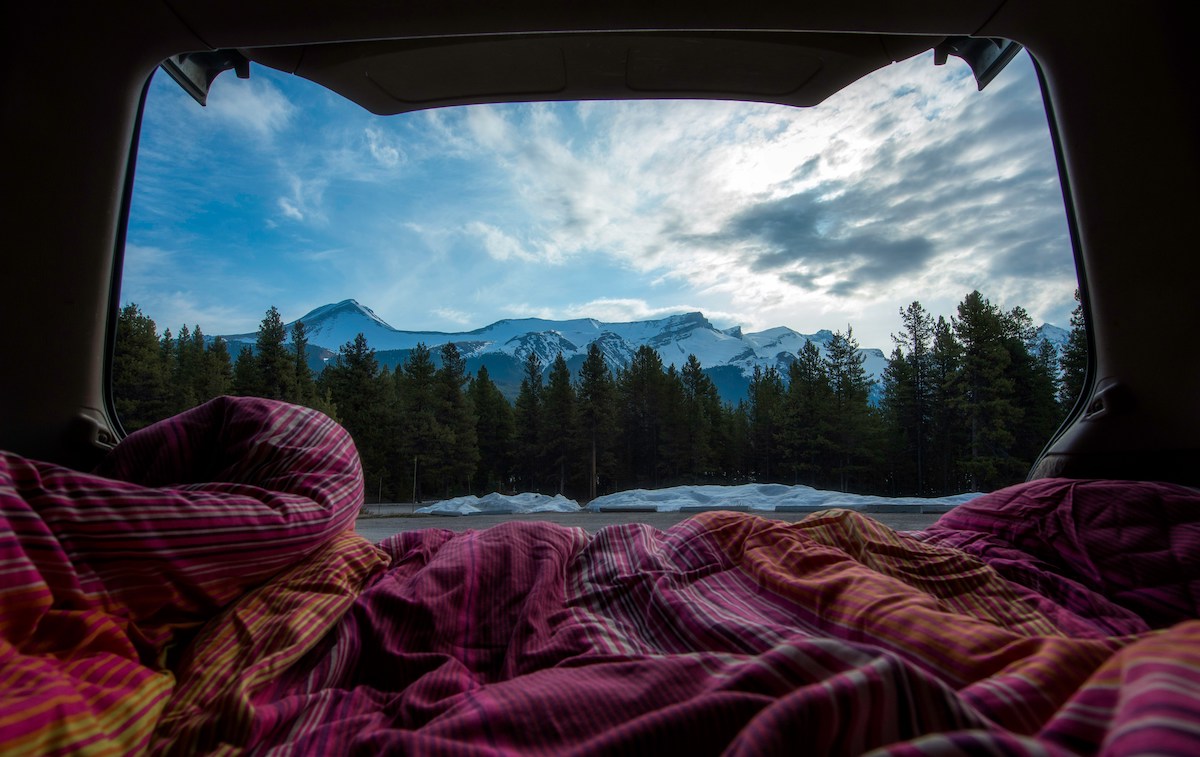

Nearly one in three campers (31.2%) go winter camping, according to The Dyrt. This is a sharp increase from less than a decade ago.
Videos by Outdoors with Bear Grylls
The company says its data showed a 40% increase in winter camping between 2019 and 2021, and the trend has not slowed down, even after pandemic restrictions lifted and people had more options for leaving the house than going on a camping trip.
“The fact that the rate of winter camping remains level from the height of the pandemic is remarkable,” The Dyrt’s CEO Kevin Long said in a press release. “Travelers have every option available to them again, but winter camping remains at an all-time high. People bought the gear, braved the elements and fell in love with enjoying the great outdoors at a quieter, cozier time of year.”
If you’re willing to be chilly at times, you can enjoy the benefits of cold-weather camping, which often includes fewer people and fewer insects. The downside, of course, is usually the cold itself, which is hard to avoid when winter camping—even in the desert and places without snow on the ground.
As you plan for a winter camping trip, you must think about how you’re going to stay warm, particularly on those winter nights when you face below-freezing temperatures.
You should know the risks associated with being outside in cold temperatures for long periods, and you should know which winter conditions could signal danger.
Having the right gear will make your winter adventures safer and more fun. In this article, we’ll cover some winter camping tips for planning, packing, staying safe, and generally making the most of cold-weather camping.
How to Plan and Prepare for a Winter Camping Trip
At a Glance:
- Do you want to be around other people?
- Can you and your gear handle the constant cold?
- Do you have snow gear, or are you willing to buy some?
- What type of camping do you want to do?
- What activities do you want to enjoy while camping?
- Always check the weather forecast.
Consider the type of experience you want to have when planning a winter camping trip. Some locations are quite popular in the winter because they’re too hot to visit other times of the year. You’ll have other places largely to yourself because other hikers and campers don’t want to brave the cold.
When choosing a location for a winter camping trip, also consider what you and your gear can handle. Are you mentally and physically prepared for cold temperatures all day and all night?
If not, choose a destination that’ll give you some sun and warmth during daylight hours, weather permitting. For instance, many desert areas will offer some warm air during the day, paired with cold nights.
Do you have snow gear for winter hikes and winter-specific camping gear, like a winter tent and a winter sleeping bag (or an RV)? If not, choose a location without snow on the ground.
If you want to go snow camping but don’t have the gear yet, we recommend buying some specialized items that’ll help you fully enjoy a winter wonderland.
Will you be RV camping, car camping (when your car is next to your campsite or accessible while you’re camping), or doing some winter backpacking? The type of camping you plan to do will also help you select a location.
You might select a location based on the activities you want to enjoy while camping. For instance, do you want to hike or go cross-country skiing?
Finally, when choosing a spot for winter camping, always check the weather forecast ahead of time and then again right before you leave, preferably as you’re packing.
Essential Winter Camping Gear
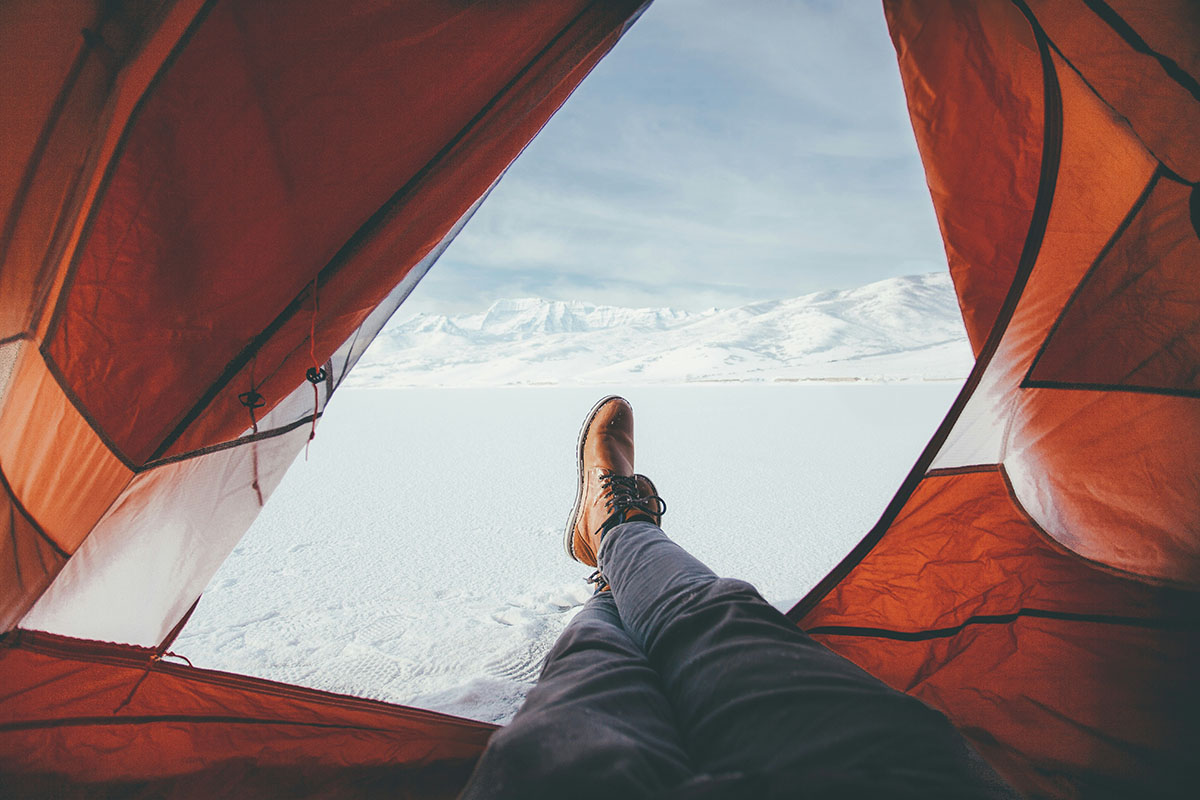
For a list of what you should bring on a camping trip, consult our ultimate camping packing list and check out our list of essential winter camping items.
When winter camping, you should adjust your packing list to account for freezing temperatures. Staying warm is a priority.
Essential winter camping gear includes layers of warm clothing, a winter-appropriate shelter, winter-approved sleep gear, and some winter-specific safety gear.
What to Wear Winter Camping
Winter campers know that cold affects your body in ways you’ll need to be prepared for. When exposed to the cold, your body loses heat faster than it makes it. Therefore, your body will spend a lot of energy trying to keep your body temperature up.
You can help your body out by wearing multiple layers of clothes to retain body heat. When layering, go for three layers—a base layer, an insulating layer, and an outer waterproof layer. The first two layers help you stay warm, while the outer layer keeps you dry and offers wind protection.
Keep these additional layering tips in mind:
- The base layer (think long johns) should be made out of moisture-wicking material.
- A warming layer, or mid-layer, serves as insulation. Fleece is often a good option.
- The waterproof layer is an outer shell that shields you and the other layers from getting wet. Wet clothing is not going to help you stay warm, so don’t skip the outer layer.
Finally, mind your extremities. Keep your head warm with a hat or beanie, avoid overly cold fingers with the help of winter gloves, and keep your feet warm and dry with warm socks and the proper winter footwear.
Learn more about how to layer for a winter day hike and the best winter jackets for extreme cold.
Choose a Shelter Fit for Winter
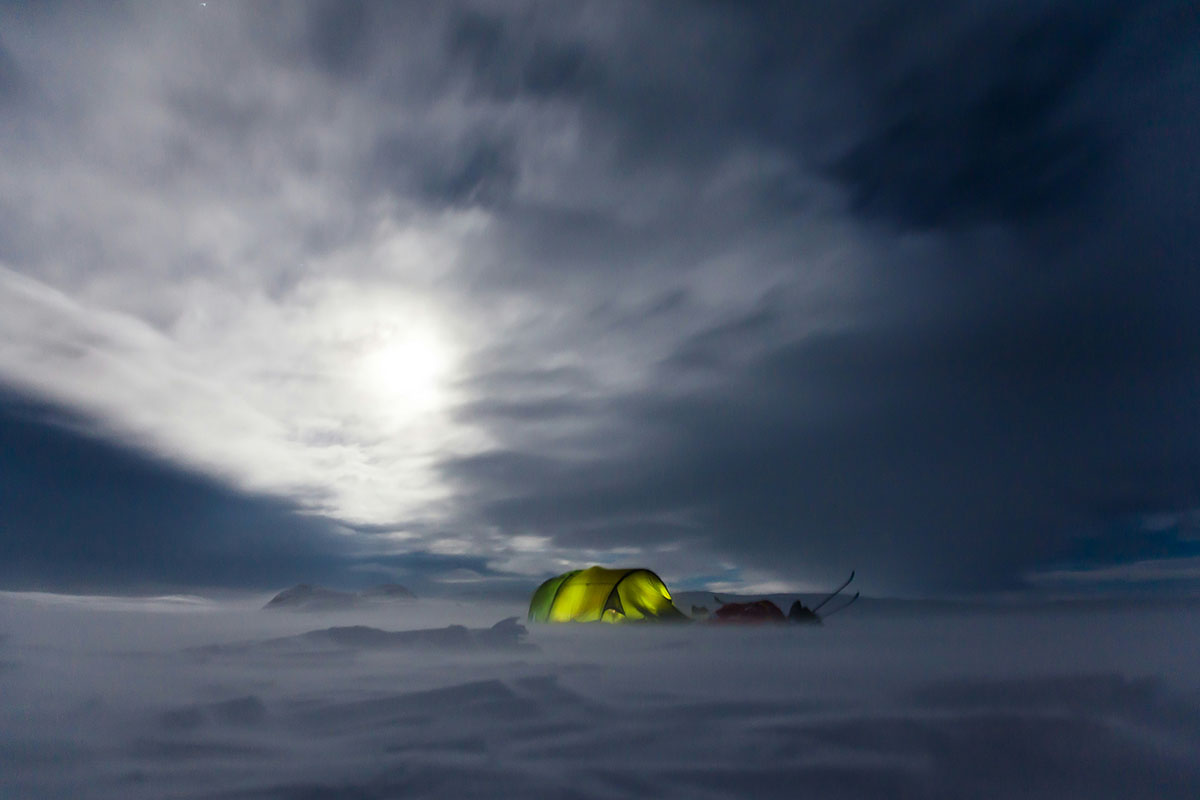
If you want a good night’s sleep even on a cold night, you’ll need more than a sleeping bag; you’ll need a shelter that can protect you from the elements.
If you’re winter camping in an RV, you’ll have the benefit of a heater. If you’re in a tent, though, choose one that’ll withstand the coldest temperature you’ll face on your winter camping trip.
One option is to choose a four-season camping tent—a tent built for heat retention. Compared to a three-season tent that prioritizes airflow to keep heat from building up inside, winter camping tents will keep more heat inside on purpose, which is very helpful during the winter.
Even with a four-season tent, keeping warm inside your shelter may require some extra gear. You can use a tent heater, or check out all of our tips for safely heating your tent.
Winter Camping in a Hot Tent
One way to ensure a good night’s sleep is to go hot tent winter camping, which requires a specialized winter tent that can accommodate a chimney for a wood-burning stove.
Hot tents are more complex than standard pole tents and are defined by some of the following features:
- An opening for an exhaust pipe
- Canvas material
- A removable floor
A wood-burning stove is what’ll put the “hot” in your hot tent. Since burning fuel releases carbon monoxide, you can’t use a fuel-burning heater inside a tent without proper ventilation. Hot tents offer a port in the roof or wall for a wood stove’s exhaust pipe.
Hot tents are often made from canvas that’s designed to withstand tough winter conditions and hold in heat. They typically also offer a removable tent floor.
A hot tent is usually spacious, accommodates the aesthetically pleasing wood-burning stove vibe, and brings your cooking inside, which can be nice when it’s freezing. They’re often heavy and not as easy to set up as a regular tent. Hot tents will often cost a bit more, too.
To use a hot tent safely and effectively, ensure the exhaust pipe is attached correctly to the port so the smoke goes out and cold air doesn’t seep in. Follow the wood stove manufacturer’s instructions carefully.
Winter-Approved Sleep Gear
Your cold-weather sleep gear should include some or all of the following items:
- Two sleeping pads
- Air mattress or camping cot
- Sleeping bag liner
- Sleeping bag with an appropriate temperature rating
One of the best ways to keep your body temperature up at night is to be prepared with a sound sleep system that’ll keep you up off the cold ground.
To keep your body warm, you should bring not only a warm sleeping bag but also a sleeping pad (or, better yet, two sleeping pads) and a sleeping bag liner. You can also put additional layers between you and the cold ground by adding items like an air mattress or a camping cot.
The right sleeping bag for winter will likely be a four-season sleeping bag that’s designed to withstand the temperatures of the environment you’re camping in. Check the temperature rating before buying a sleeping bag to make sure it’ll work for winter camping.
Winter-Specific Safety Gear
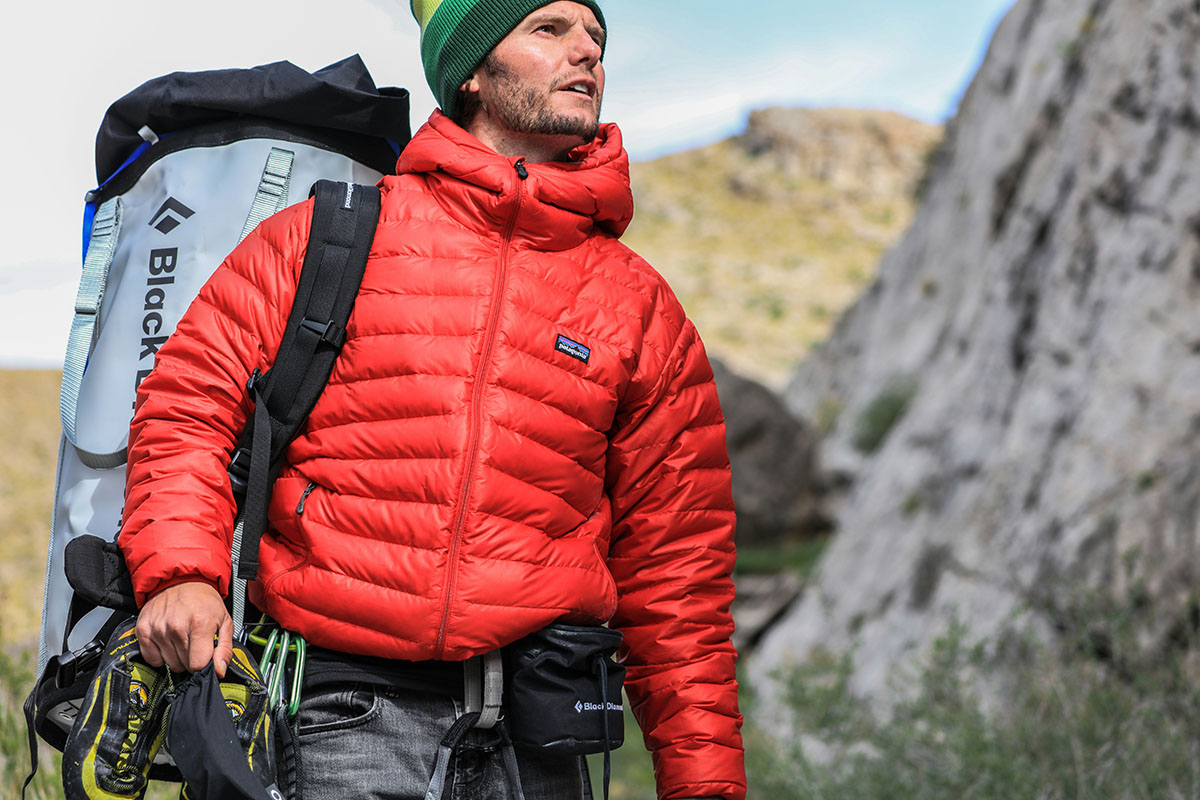
When cold-weather camping, you should bulk up your emergency gear. In cold weather, it’s particularly important to have an emergency blanket on hand and some extra hand and foot warmers.
If you are hiking in a mountainous area covered by snow, invest in an avalanche beacon, also called an avalanche transceiver. Avalanche beacons are specially designed to make it easier to find you if you get buried in an avalanche. More avalanche safety tips are below.
Safety Considerations for Winter Camping
When camping in the frontcountry or the backcountry, during winter or during summer, you should always tell someone where you’re going before you go. Share your location and basic itinerary with someone outside of your travel group, just in case you get lost and need to be found.
It’s best practice, especially when backcountry camping, to carry a communication device beyond your cell phone. Consider a satellite-connected device or person-locating beacon. In winter, always watch out for danger zones, including thin ice, unstable trees, and avalanche-prone areas.
It’s generally safe to walk on ice that’s thicker than four inches. If your winter camping trip includes ice skating or ice fishing, prepare to measure the ice’s thickness before you walk on it. You can test the ice by cutting or drilling into it with an ice chisel, ice auger, or a cordless drill.
Any time of year, avoid camping under or near dead or dying trees. These trees, nicknamed “widowmakers” can drop lethal branches at any time, but they’re particularly dangerous in high winds.
Avalanche Awareness

On average, 28 people die in avalanches every winter in the United States. When victims get caught up in an avalanche, if they survive the impact, they get buried in snow and run the risk of suffocating or becoming hypothermic.
Victims stand the best chance of survival if they’re rescued within the first 20 minutes after the incident.
Most avalanches occur on 30-45-degree slopes and travel 60-80 miles per hour. Peak avalanche season is from December through March.
When winter camping, know about the local avalanche risk and understand warning signs that might happen. Signs of avalanches before they occur include recent avalanches in the area and cracks across slopes.
Avoid areas under or near steep slopes, especially those greater than 30 degrees. If you’re in an avalanche-prone area, carry the proper equipment, including a helmet, an avalanche beacon, an avalanche airbag, a collapsible avalanche probe, and a small shovel.
Hypothermia Warning Signs
Hypothermia occurs when a person has an abnormally low body temperature due to exposure to the cold.
According to the Centers for Disease Control (CDC), early warning signs of hypothermia are shivering, fatigue, loss of coordination, and confusion or disorientation. Late symptoms include no shivering, blue skin, dilated pupils, and a slowed pulse.
Frostbite Warning Signs

Frostbite causes a loss of feeling in parts of the body—often extremities like the nose, ears, cheeks, chin, fingers, or toes. Frostbite can permanently damage tissues. The CDC lists symptoms of frostbite as numbness, tingling or stinging, aching, and bluish or pale skin.
Carbon Monoxide Poisoning
When heating your tent or shelter, ventilate adequately to avoid a buildup of carbon monoxide inside your space, which can be deadly. The most common symptoms of carbon monoxide poisoning include headache, dizziness, weakness, upset stomach, vomiting, chest pain, and confusion.
More Winter Camping Tips
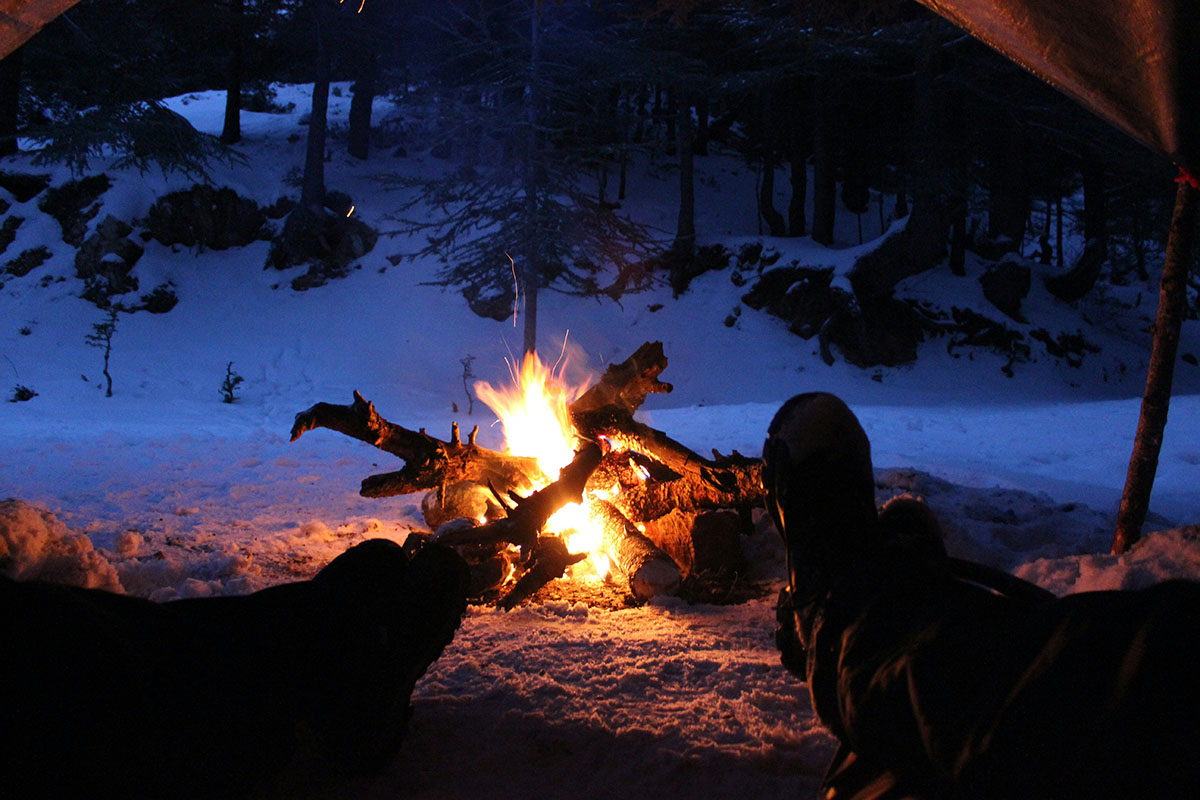
Embrace the season by snowshoeing, skiing, cross-country skiing, or winter hiking while you’re winter camping.
Plan and cook simple and hearty meals, eat enough calories to offset the work your body will be doing to keep itself warm and drink warm liquids like hot chocolate or tea to help you stay warm from the inside out.
Keep these other tips in mind, too.
Use Lithium Batteries in Cold Weather
If you plan to bring battery-powered equipment, know that most batteries have a hard time working in cold weather. However, lithium batteries, due to their chemical properties, aren’t as affected by cold temperatures. Here are our suggestions for the best power banks for camping.
Tips for Making Camp in the Snow
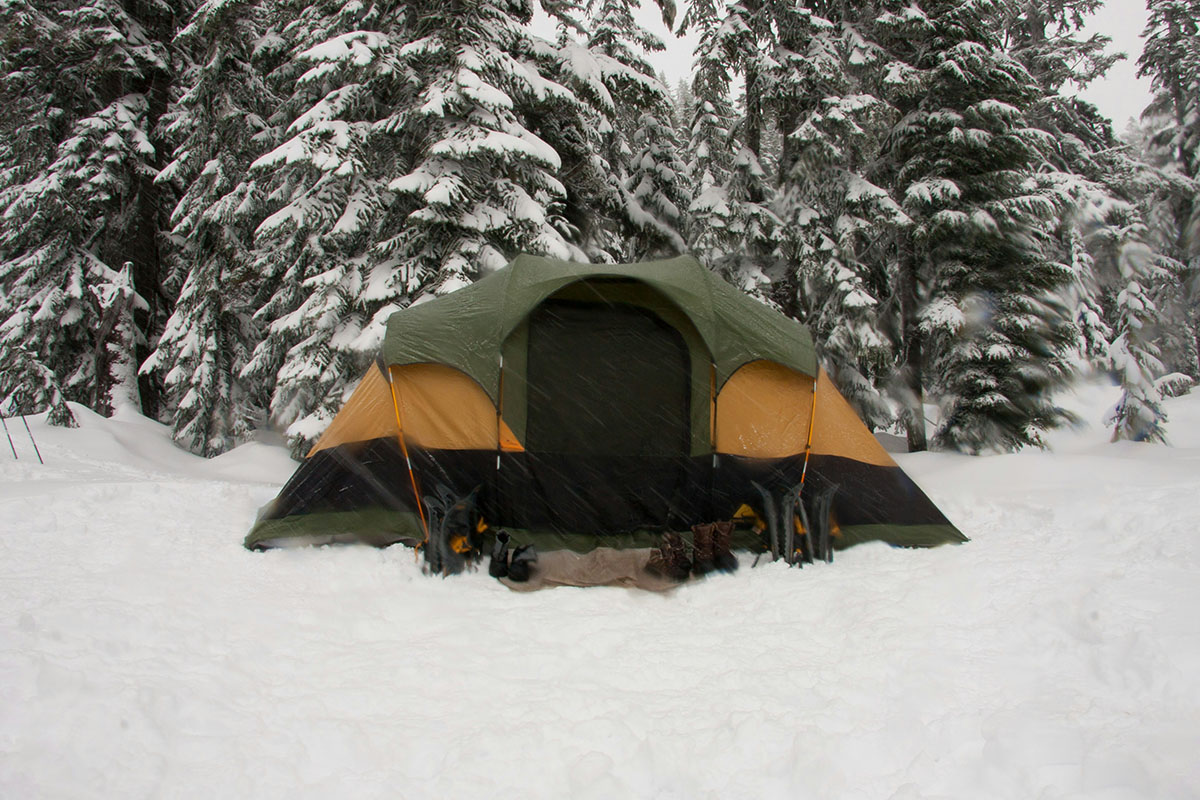
Wondering how to set up a tent in the snow? Here is some advice.
- Find a flat area and be aware of hazards while selecting the best place for your campsite. Clear the snow of any debris for tent placement.
- Pack down the snow before you set down your tarp or tent footprint. Packed snow is preferable to loose snow beneath your shelter.
- Use snow stakes to stake down your tent instead of regular stakes. Attach the rainfly for extra protection against wind and elements.
Bonus Tips for Staying Warm
Besides wearing the proper clothing and having a winter-ready shelter and sleep setup, here are a few more ideas for winter campers looking to stay warm:
- Stay active as much as possible
- Stay dry as much as possible
- Use hand and foot warmers
- Put hot drinks instead of cold drinks in your canteen to sip on throughout the day
- Use a hot water bottle to warm up your sleeping bag before bed
- Consider different ways to safely heat your tent
Leave No Trace
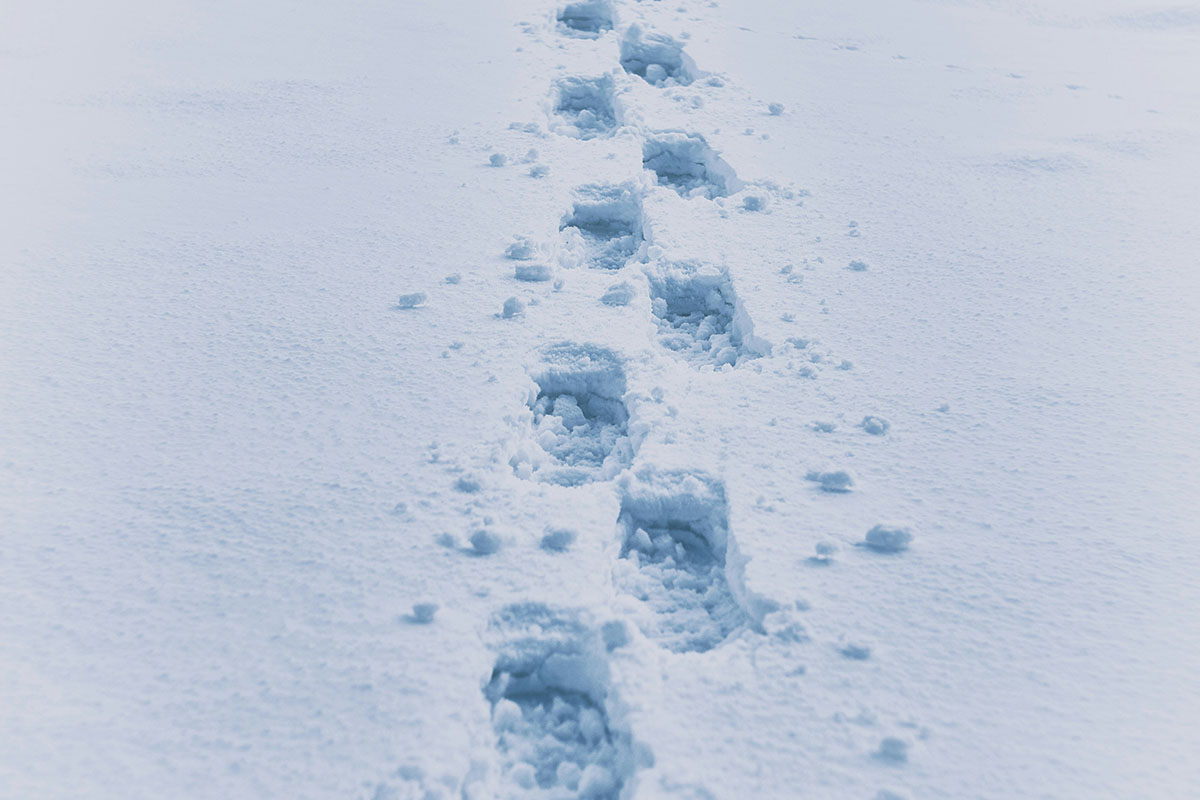
Outdoor areas are susceptible to damage in the winter because people don’t necessarily think they are making an impact on vegetation that they can’t see.
However, winter campers should follow Leave No Trace principles, just like they do other times of year.
When going to the bathroom outside in the wintertime, urinate at least 200 feet away from any water source, and, if there are no toilets available, pack out your solid waste.
Upon leaving your campsite, destroy any snow shelter or snowmen you made while there, leaving the area as it was when you arrived.
Know When It’s Too Cold
Is there such a thing as too cold for winter camping? Yes, but what that limit is varies for each person. Understand your own limitations and the limitations of your gear before setting out for some winter camping.
Consider acclimating your body to cold environments in small doses first. That way, you’ll have some experience coming back from being cold, and you’ll have a better idea of what you’re comfortable enduring.
Know the symptoms of cold-related illnesses such as hypothermia and frostbite before you head out.
Final Thoughts
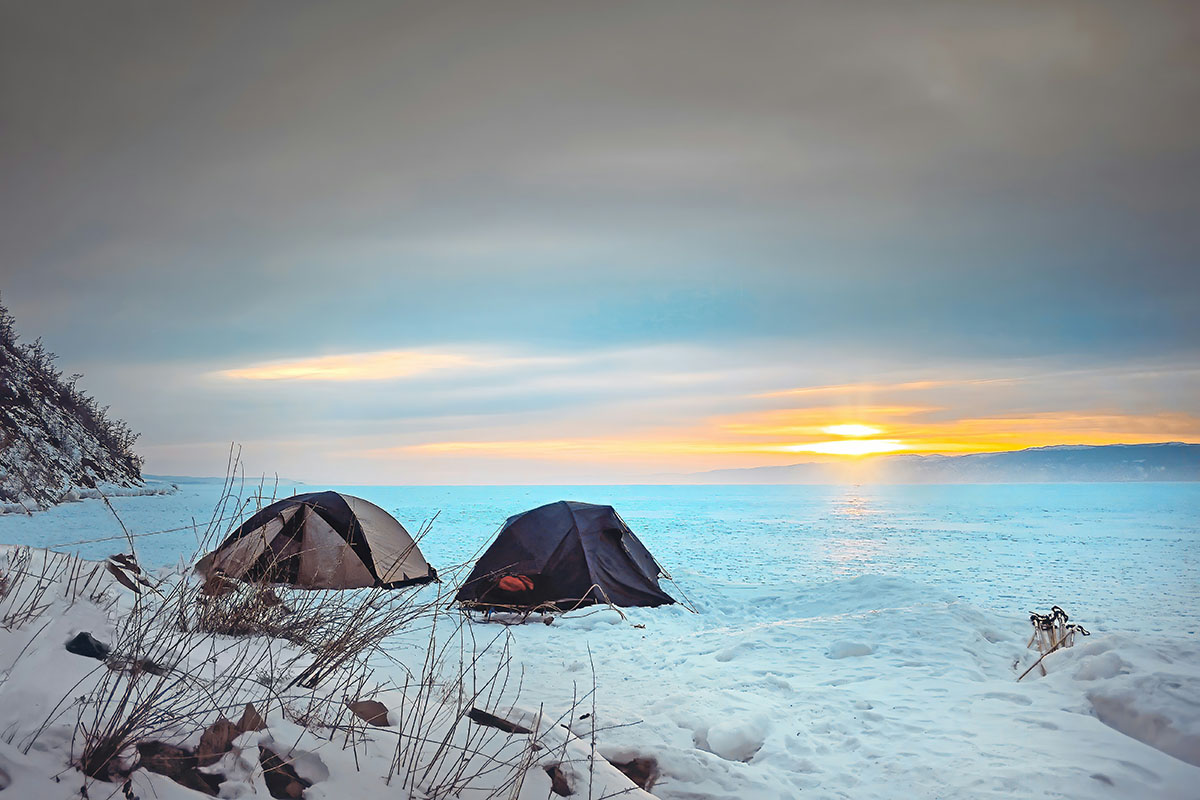
Cold-weather camping can be a fun way to spend time outdoors. You can experience the beauty of winter and take part in some cold-weather adventures unavailable during warmer times of the year.
Before you go winter camping, though, be sure you’re geared up and prepared to make the most of the experience, despite chilly temps.


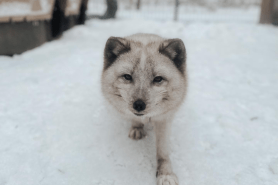

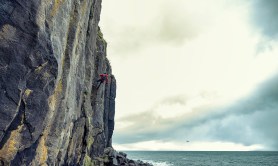

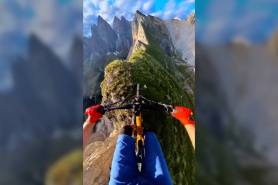
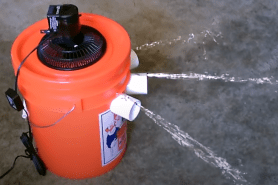
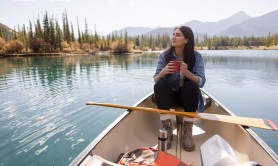

Pingback: The right way to Keep Heat in a Tent [Helpful Tips and Strategies] - Best Selling Products